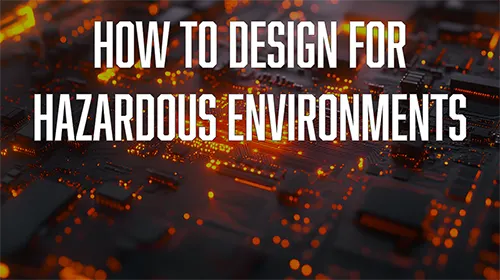How to Design for Hazardous Environments
Safe and resilient product design is essential for all products, regardless of their intended use. However, poorly designed products for hazardous environments can have dire consequences. In 2010, the BP Deepwater Horizon oil drilling site exploded, killing 11 people and leaking nearly 5 million barrels of oil into the Gulf of Mexico over a period of several days. The root of the problem was a recently installed concrete core that had been cured with nitrogen gas, making it too weak for the highly pressurised environment.
What is a Hazardous Environment?

A hazardous environment is a setting where conditions pose significant risks to health, safety, or the surrounding ecosystem. Flammable gases, vapours, and fibres are common causes of hazardous environments. The Deepwater Horizon environment was hazardous due to the high-pressure drilling conducted deep underwater, the presence of flammable hydrocarbons, and limited ventilation. Combining these factors together led to a horrendous outcome.
Industries regularly working in hazardous environments include oil and gas, offshore drilling, underwater operations, construction, rail transportation, and chemical processing. Strict safety protocols and good product design are essential to protecting workers and the environment in these industries.
What are the Hazardous Location Classifications?
ATEX is the EU directive for equipment safety standards in explosive environments.
These zones classify hazardous environments:
- Zone 0: Gas, vapour, or mist causes a continually present explosive environment
- Zone 1: An explosive environment could likely form because of gas, vapour, or mist
- Zone 2: While unlikely, gas, vapour, or mist makes it possible for an explosive environment to form
- Zone 21: There is a high risk of explosive powder or dust forming
- Zone 22: There is a medium risk of explosive powder or dust
Following Brexit, the UK introduced the UKEX classification as an alternative to the EU-governed ATEX classification. Although the requirements are essentially the same, equipment used in both the UK and the EU must be certified by both bodies. A2E, one of Pivot’s Scotland-based companies, are experts in designing products for hazardous environments, having designed several products for ATEX zones 0, 1, and 2.
ATEX-certified equipment is classified into two categories: Group I and Group II. Equipment in Group I often concerns mines and has methane and gas atmospheres. Equipment in Group II has gas, vapour, mist, or dust atmospheres, and includes all other above-ground industries not in Group I.
Areas are classified by categories.
- Category 1: Explosive atmosphere is continuously present
- Category 2: Explosive atmosphere occurs between 0.1 to 10% of the year
- Category 3: Explosive atmosphere is unlikely to occur in regular operation
It is essential to conduct a thorough risk assessment when designing products for hazardous environments. Certification requirements in the end-use region should guide the risk assessment.
In North America, classification and certification are handled by the National Electrical Code (NEC) in the US and the Canadian Electrical Code (CEC) in Canada. These protocols have similar concepts and requirements to ATEX/IECEx. However, instead of basing hazard classification on the frequency and duration of the explosive environment, division classification is based on normal vs. abnormal conditions. NEC and CEC protocols also permit self-testing, whereas ATEX requires third-party certification. Overall, while requirements are similar across different countries, it is essential to verify and reference all relevant protocols when designing, testing, and conducting risk assessments on products.
How Can I Design for Hazardous Environments?
The IEC and EN set guidelines for electrostatic discharge prevention (ESD). Materials must be highly resistant to their environment, as even a minor static electricity discharge could serve as an ignition source. Products must also be resistant to corrosion, chemical degradation, pressure, and impact.
Enclosure Design
Enclosure design is vital in limiting heat and preventing explosive environments. Every gas and dust have a specific auto-ignition temperature. Temperatures are controlled through design, including the selection of materials, circuit design, and heat dissipation mechanisms (e.g., heat sinks). Proper enclosure designs for hazardous environments are typically rated IP66 or higher, with the first six signifying that the product is dust-tight, and the second six signifying that the product is protected against powerful water jets.
Electrical Design
Limiting heat starts with electrical design. Good designs will not ignite, even under hazardous conditions. Under ATEX/IECEx:
- Ex ia is the protection level for Zone 0, where electrical design is safe with two faults.
- Ex ib is the protection level for Zone 1, where electrical design is safe with one fault.
- Ex e signifies increased safety measures, including limitation of sparks, hot surfaces, and insulation.
- Ex e can be given to products that are rated IP54 or higher, where enclosures are protected against dust and splashing water.
Mechanical Design
Temperature control is also a factor in mechanical design. Heat-conductive materials help with dissipation, and designers should avoid creating spaces that trap heat or generate friction. Opt for robust materials and remember to account for UV exposure.
Additionally, use gaskets rated for the specific zone of the end product, and check your design for areas that could trap moisture or dust. Finally, do not forget ergonomics in mechanical design. Controls should be glove-friendly to account for the PPE worn in hazardous environments, and visuals should be clear and visible at all times.
How to Certify your Product for Hazardous Designs?
Third-party certification is the best way to ensure that products meet safety standards. Though internal testing is an essential step in creating a viable product, third-party testing eliminates any bias and builds trust, in addition to being a requirement in many places. Third parties verify that a product can withstand use, time, and their environments, in accordance with global regulations. These certifications also provide traceability and documentation, which is important for any future audits and accident reports.
Key Certification Bodies and Standards
Europe:
- IECEx (IEC System for Certification to Standards Relating to Equipment for Use in Explosive Atmospheres)
- ATEX (Atmosphères Explosibles) Directives (EU)
- Other regional certifications (e.g., EAC for Eurasian Economic Union)
North America:
- UL (Underwriters Laboratories)
- CSA (Canadian Standards Association)
- FM Approvals
- NEC (National Electrical Code) / NFPA (National Fire Protection Association)
- CEC (Canadian Electrical Code)
Companies must maintain compliance with these standards over time. As parts are repaired, replaced, or come end of life, they must be held to the same standards as the original components. Failure to maintain compliance was the undoing of Deepwater Horizon, as the part that caused the explosion was a recent replacement that did not match the original’s quality. Design updates must also comply with international safety standards, and all inspections and changes require technical documentation.
Designing for hazardous environments is only the first step. What happens after the product leaves the lab matters just as much. Certifications such as ATEX, IECEx, UL, and CSA are based on the overall system’s performance under real-world conditions. Manufacturers are responsible for more than just design—they must track documentation, follow quality control processes, and reverify certifications whenever a change is made. Hazardous environments leave no room for assumptions. The safety of workers, the environment, and the operation depend on whether that equipment continues to meet the standard for which it was certified. When compliance is done right, it protects everything around it. When it is ignored, the results speak for themselves.
For more than three decades, Pivot International has been at the forefront of designing, testing, and certifying products for some of the most challenging and hazardous environments on the planet. Our expertise spans a wide range of specialist applications, including high-temperature engineering and endurance testing for electronics deployed in drilling operations and downhole tools, as well as the development of pressure-tolerant assemblies for electric subsea ROVs operating in extreme depths.
We are highly experienced in supporting projects that require ATEX-certified solutions, ensuring compliance with rigorous safety and performance standards essential for hazardous area equipment. From concept to certification, our engineers bring a deep understanding of environmental stresses, regulatory requirements, and practical field use.
If you’re seeking a proven partner to deliver robust, compliant, and reliable designs for hazardous or explosive atmospheres, contact a member of our team to explore how we can support your next project.

